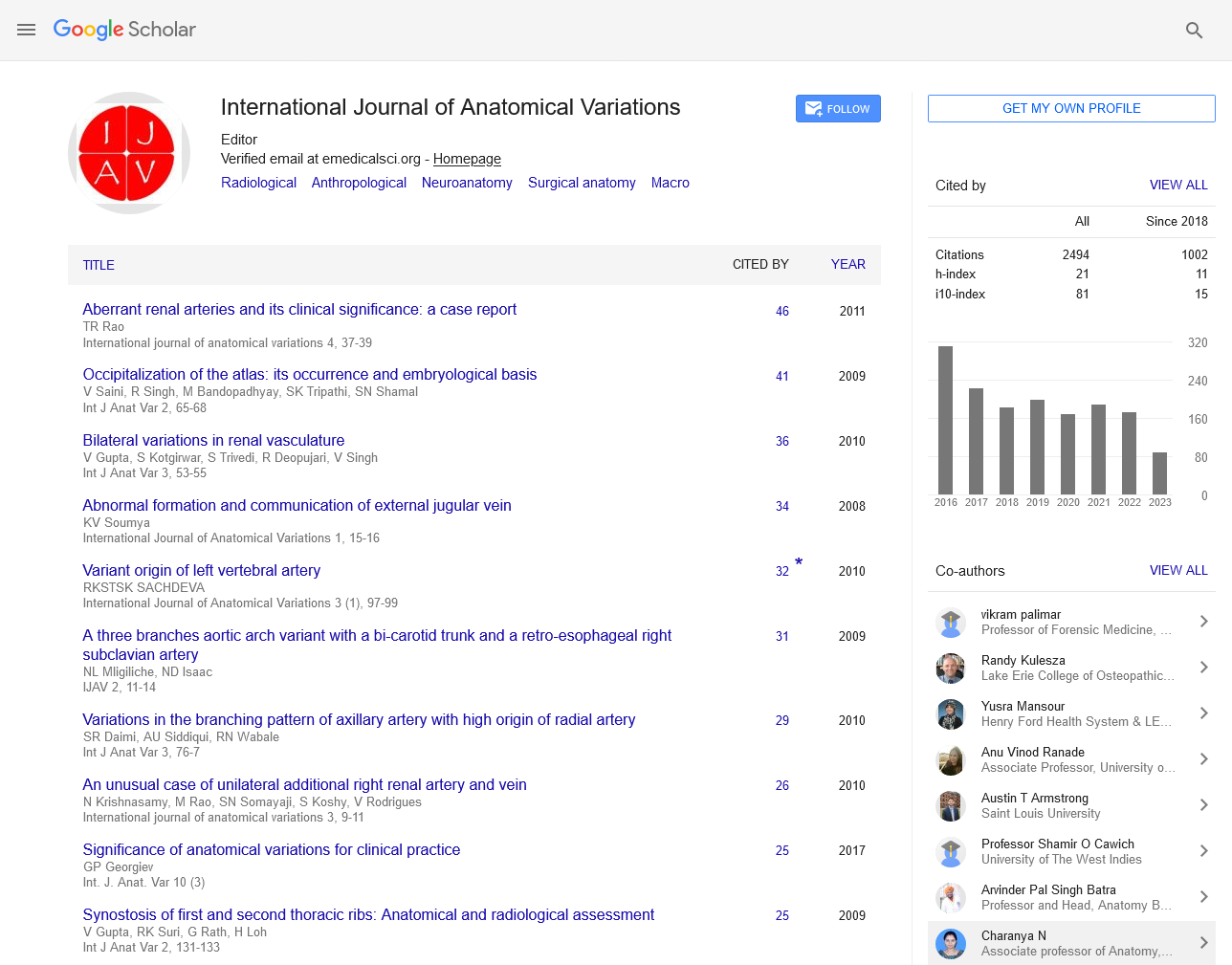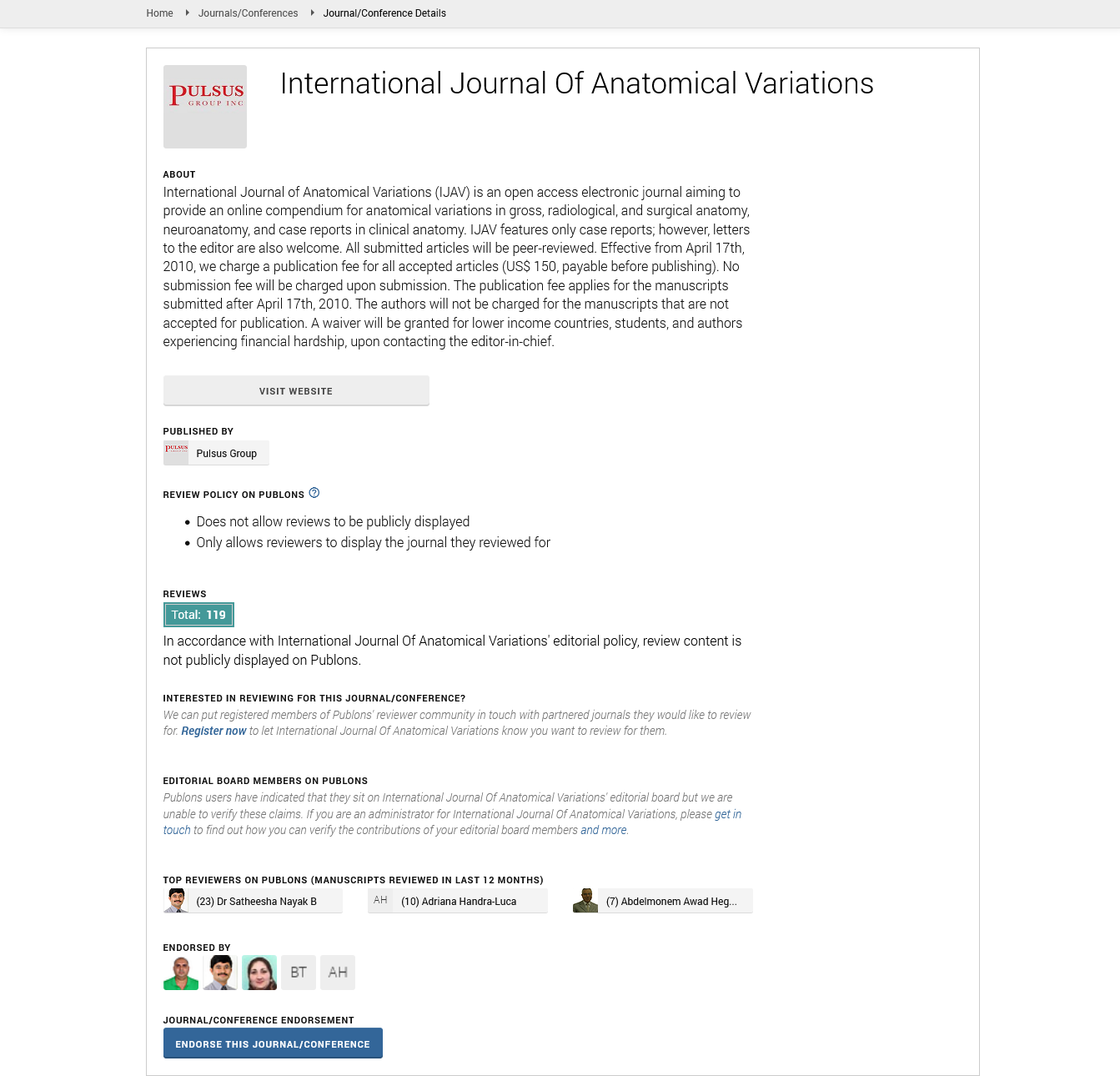Anatomical Variations Clinical Relevance Prevalence and Implications for Surgical Practice
Received: 01-Feb-2025, Manuscript No. ijav-25-7624; Editor assigned: 04-Feb-2025, Pre QC No. ijav-25-7624 (PQ); Reviewed: 19-Feb-2025 QC No. ijav-25-7624; Revised: 26-Feb-2025, Manuscript No. ijav-25-7624 (R); Published: 28-Feb-2025, DOI: 10.37532/1308-4038.18(2).488
Citation: Singh A. Anatomical Variations Clinical Relevance Prevalence and Implications for Surgical Practice. Int J Anat Var. 2025;18(2): 743-744.
This open-access article is distributed under the terms of the Creative Commons Attribution Non-Commercial License (CC BY-NC) (http://creativecommons.org/licenses/by-nc/4.0/), which permits reuse, distribution and reproduction of the article, provided that the original work is properly cited and the reuse is restricted to noncommercial purposes. For commercial reuse, contact reprints@pulsus.com
Abstract
Anatomical variations refer to the naturally occurring differences in the anatomical structures of individuals, often without pathological significance. These variations, while typically benign, can have significant implications for clinical practice, especially in diagnostic imaging, surgical procedures, and interventional approaches. This paper aims to provide a comprehensive review of common and clinically significant anatomical variations across different systems, their embryological basis, prevalence, and their potential impact on medical and surgical outcomes. Understanding anatomical variability is crucial for minimizing iatrogenic injuries and improving patient outcomes.
INTRODUCTION
Human anatomy has long been the cornerstone of medical education and practice. However, not all individuals conform to the "standard" anatomical models typically depicted in textbooks. Anatomical variations, defined as deviations from the most common form without pathological consequences, are prevalent in all populations [1]. These variations, while often asymptomatic, can significantly impact clinical assessments and surgical interventions if unrecognized. Therefore, a thorough understanding of anatomical variability is critical for healthcare providers, particularly surgeons, radiologists, and anatomists. Anatomical variations are common deviations from the standard anatomical structures described in classical literature. While these variations are typically within the spectrum of normal human anatomy and often asymptomatic, their presence can hold considerable clinical and surgical significance [2]. In recent decades, with the advancement of imaging modalities, endoscopic procedures, and minimally invasive surgical techniques, the recognition and understanding of these variations have become increasingly vital. From vascular anomalies and muscular differences to nerve path deviations and atypical organ positioning, anatomical variations can influence disease presentation, complicate diagnosis, and alter the approach and safety of surgical procedures. For clinicians, especially surgeons, being aware of these variations is crucial to avoid iatrogenic injury, ensure accurate interpretation of imaging, and enhance surgical planning. For instance, failure to recognize a variant hepatic artery during abdominal surgery or an anomalous course of a nerve during orthopedic procedures can result in serious intraoperative and postoperative complications. Furthermore, the prevalence of certain variations may differ based on population demographics, genetic factors, or environmental influences, making it important to consider these factors in both clinical practice and anatomical education. This review aims to provide a comprehensive overview of the most commonly encountered anatomical variations, their documented prevalence, and the clinical relevance of these findings. Special emphasis is placed on their implications for surgical practice, highlighting the need for thorough preoperative assessment, meticulous surgical technique, and continuous anatomical education. By fostering a deeper understanding of anatomical diversity, healthcare professionals can improve patient outcomes and reduce the risk of preventable errors in clinical and surgical settings [3].
CLASSIFICATION OF ANATOMICAL VARIATIONS
Anatomical variations can be classified based on the system they affect, their embryological origin, or their clinical relevance [4].
EMBRYOLOGICAL BASIS OF ANATOMICAL VARIATIONS
Many anatomical variations arise from deviations during embryological development. Processes such as incomplete regression, abnormal fusion, or persistence of embryonic structures can lead to anatomical differences. Persistent median artery results from the failure of the embryonic artery to regress. Accessory spleens originate due to the failure of splenic buds to fuse. Retro esophageal right subclavian artery results from abnormal aortic arch development. Understanding the embryological basis helps in anticipating variations and explaining their presence during dissection, imaging, or surgery [5].
COMMON ANATOMICAL VARIATIONS BY SYSTEM
Often incomplete or asymmetrical, with variations in the anterior communicating artery being most common. Multiple renal arteries occur in 25–30% of individuals. A rare variation that can complicate retroperitoneal surgery or venous catheterization.
MUSCULOSKELETAL SYSTEM
Found in ~5-10% of individuals, typically asymptomatic but may be mistaken for a tumor on imaging. Os trigonum and os acromiale are common in the foot and shoulder respectively, sometimes causing pain or affecting mobility. An extra rib from the seventh cervical vertebra, can lead to thoracic outlet syndrome.
IMAGING AND DIAGNOSTIC CONSIDERATIONS
Modern imaging modalities such as CT, MRI, and Doppler ultrasound have made it easier to identify and document anatomical variations preoperatively. Radiologists must be familiar with variations to avoid misinterpretation.
ANATOMICAL VARIATIONS IN SURGICAL EDUCATION
Incorporating knowledge of variations into medical and surgical training improves diagnostic accuracy and surgical safety. Cadaver dissection, 3D imaging, and virtual simulations can aid in recognizing and understanding variations.
CONCLUSION
Anatomical variations are common and generally harmless but have the potential to complicate diagnosis, treatment, and surgery if not properly recognized. A detailed understanding of these variations, their embryological origins, and clinical implications is crucial for all healthcare professionals. Incorporating this knowledge into clinical practice enhances patient safety and surgical success.
REFERENCES
- Hitchhiker’s Thumb (Distal Hyperextensibility): Symptoms, Causes & Outlook. (n.d.). Retrieved December 8.
- Inzinger M, Massone C, Arzberger E, Hofmann-Wellenhof R (2013) Hair repigmentation in melanoma. The Lancet 382: 1224.
- Boumba V, Ziavrou K, Vougiouklakis T (2006) Hair as a biological indicator of drug use, drug abuse or chronic exposure to environmental toxicants. Int J Tox 25: 143-163.
- Cappella A, Bertoglio B, Di Maso M, Mazzarelli D, Affatato L et al.(2022) Sexual Dimorphism of Cranial Morphological Traits in an Italian Sample: A Population-Specific Logistic Regression Model for Predicting Sex. Biology 11: 1202.
- Harris JE, Eng JJ (2006) Individuals with the dominant hand affected following stroke demonstrate less impairment than those with the no dominant hand affected. Neuro rehabilitation and neural repair 20: 380-389.
Indexed at, Google Scholar, Crossref






